The Kuti Rishi of Isaan
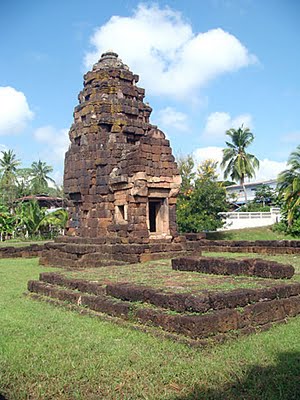 The central laterite tower at Kuti Rishi Ban Nong Bua Lai, with the foundations of the library in the foreground
The central laterite tower at Kuti Rishi Ban Nong Bua Lai, with the foundations of the library in the foregroundLabels: Isaan, Kuti Rishi, Prasat Muang Tam, Prasat Phnom Rung
Cambodia - Temples, Books, Films and ruminations...
 The central laterite tower at Kuti Rishi Ban Nong Bua Lai, with the foundations of the library in the foreground
The central laterite tower at Kuti Rishi Ban Nong Bua Lai, with the foundations of the library in the foregroundLabels: Isaan, Kuti Rishi, Prasat Muang Tam, Prasat Phnom Rung
Labels: Water Festival
Eric de Vries likes taking pictures in Cambodia. In fact, the native of Netherlands has spent the last nine years shooting photos throughout the kingdom. The acclaimed photographer is currently holding an exhibition at the Raffles Grand Hotel d'Angkor in Siem Reap. "Retrospective Cambodia 00/09" features de Vries' work from when he was either living in or visiting Cambodia. "I chose the best pictures I took from that period," de Vries says.
The exhibition includes photographs that de Vries shot of various landscapes around the country, the Angkor temples and the standoff last year between Cambodian and Thai troops near the Preah Vihear temple. When de Vries visited Preah Vihear, there were not any clashes between troops, as Cambodia and Thailand attempted to resolve the dispute diplomatically. "We - my assistants and I - had a great time up there with the troops," he recalls. "It was more like boredom and spending time (for the soldiers) to grow vegetables, and they were happy that someone was around with a camera."
A resident of Siem Reap, de Vries does fine art, commercial, documentary and news photography. He and a business partner run a café/gallery in Siem Reap where much of his work is on display. The relatively slow pace of Southeast Asia and his view that "Cambodia is a photographic heaven" are among the reasons he originally decided to come to the country. His first encounter with Cambodia occurred in 2000, when he traveled around Southeast Asia for three months. When de Vries initially visited Cambodia, he recalls how "there was something" about the country that made him want to come back for a much longer stay. "The people, the countryside, and the temples ... I was surprised by (Cambodia's) beauty and all the smiling Khmers," de Vries says. He made annual visits to Cambodia before deciding to take up residence in Phnom Penh in late 2007.
Since relocating to Cambodia, de Vries has had more than a few memorable moments as a photographer. Not surprisingly, the temples around Angkor Wat were among those memorable experiences. The Preah Vihear standoff and his documentary series, Hello Darling, about the working girl bar scene in Phnom Penh, are other fascinating encounters he's had as a photographer in Cambodia.
Born in the Dutch city of Arnhem, de Vries developed a fascination with photography when he received a camera as a birthday present when he was 14. There were more and better cameras for presents on subsequent birthdays, and he eventually decided that he wanted to become a professional photographer. While de Vries studied at a photography school in the Netherlands for two years, he says many years of practice on his own were what really allowed him to hone his skills. After living in Phnom Penh, de Vries eventually moved to Siem Reap and got married to a Cambodian woman before he and his wife had a daughter named C'moon. The 49-year-old has lots of photography work in Cambodia lined up for the coming years, and he says he plans to stay in the country for the foreseeable future. "So I have no plans of going back to the Netherlands," he says. Links: Eric de Vries FCC's The Wires
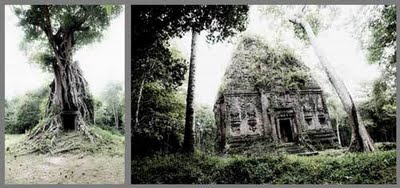 Next month, Eric will post 30 photos from his recent visit to Sambor Prei Kuk
Next month, Eric will post 30 photos from his recent visit to Sambor Prei Kuk
Labels: Eric de Vries
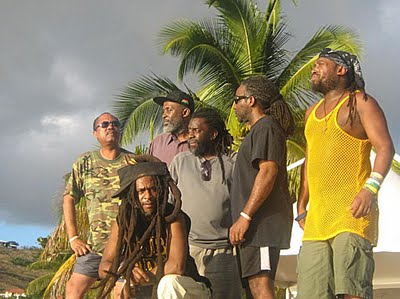 Steel Pulse looking serious. LtoR: Donovan McKitty, David Hinds, Selwyn Brown, Sidney Mills, Wayne C-Sharp Clarke & Amlak Tafari
Steel Pulse looking serious. LtoR: Donovan McKitty, David Hinds, Selwyn Brown, Sidney Mills, Wayne C-Sharp Clarke & Amlak TafariLabels: Basil Gabbidon, Steel Pulse
In 1994, residents of eight villages in northwestern Peru — a region of deserts and oases that looks much like Iraq — organized citizens’ patrols. The patrols weren’t out to stop house burglars or cattle rustlers. They were looking for looters, who, for several years, had plundered the area to feed the robust international market for pre-Inca artifacts. I spent a few days with one of these patrols in the village of Úcupe in 2002. The members were unarmed and well organized, and they knew the terrain as well as you know your dining room. When they spotted looters digging up the overgrown ancient burial mounds that dot the landscape, they surrounded them and called the police. In this way, I saw the patrols apprehend three potential looters without firing a shot.
Last year, archeologists excavated an intact tomb at Úcupe that contained the remains of a lord who ruled during the Moche civilization around A.D. 450. He was buried with golden headdresses, war clubs, silver rattles and opulent jewelry. If sold piecemeal on the black market, these objects could have fetched millions. Instead, their discovery opened the door to a new understanding of how power was exercised in the Moche world. Without the civilian patrols, this tomb would certainly have been emptied by looters. The people of Úcupe will now benefit from the archaeological tourism that often follows such discoveries and that, in Peru, is booming. They protected a community asset, and it paid off.
This kind of grassroots organizing — where local officials, police officers and archaeologists join forces with local residents — is the best way to combat looting and protect sites from being swallowed up by the illicit antiquities trade. A similar strategy has proved effective in Mali, a country that has little in common with Peru besides a rich archaeological heritage. It would work in Iraq and elsewhere. Surprisingly, though, relatively few governments have focused on getting rural people involved in protecting threatened sites. Most spend their energy pressing museums in the United States or Europe to repatriate looted artifacts, instead of focusing on safeguarding the archaeological riches still in the ground. Repatriation is a valuable goal, but an immense amount of historical information is lost whenever looting occurs and sites are damaged, even if the objects are later recovered. The government’s time would be better spent expanding the patrols to prevent looting in the first place.
In Iraq, the authorities could start by inviting provincial museums and archaeologists to work with local governments and police departments on organizing residents who live near key ancient sites. Rural citizens’ patrols aren’t expensive — they need binoculars, cellphones, maybe a few dirt bikes and some basic training. Financing could come from international conservation and community development organizations and should include money for education to encourage people to see the ruins in their midst as valuable community assets as much as potable water or clean streets. Once organized, the patrols need to be lightly armed if armed at all, and they have to be well regulated by the police. But as the good citizens of Úcupe have shown, they work. Roger Atwood, a contributing editor at Archaeology magazine, is the author of “Stealing History: Tomb Raiders, Smugglers and the Looting of the Ancient World." Find out more about Heritage Watch, click here.
Labels: Heritage Watch
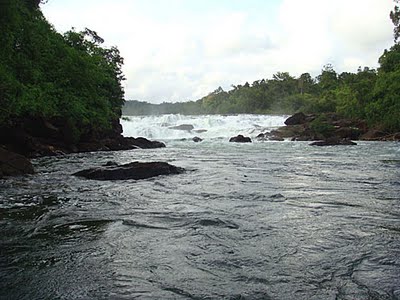 It doesn't look too dangerous but the current and swell was pretty strong and carried us downstream as soon as I took this shot
It doesn't look too dangerous but the current and swell was pretty strong and carried us downstream as soon as I took this shot 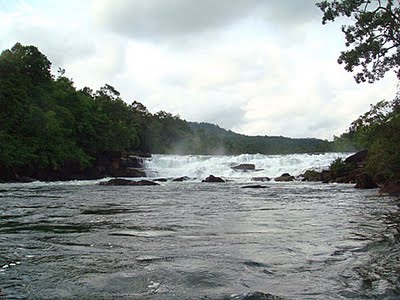 We paddled back upstream to get a bit closer to the waterfall - trying to paddle and take photos wasn't easy
We paddled back upstream to get a bit closer to the waterfall - trying to paddle and take photos wasn't easy Labels: Rainbow Lodge, Tatai Waterfall
Labels: BIDC Cup, Cambodia U-23s

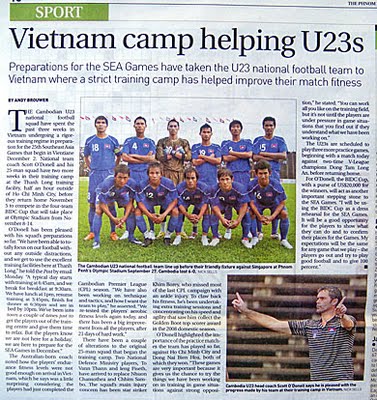 My article in yesterday's Phnom Penh Post on the Cambodian Under-23s ongoing preparation in Vietnam for the BIDC Cup in early November and the SEA Games in Laos in early December. Click here to see it online.
My article in yesterday's Phnom Penh Post on the Cambodian Under-23s ongoing preparation in Vietnam for the BIDC Cup in early November and the SEA Games in Laos in early December. Click here to see it online.Labels: Cambodia U-23s, Phnom Penh Post, Scott O'Donell
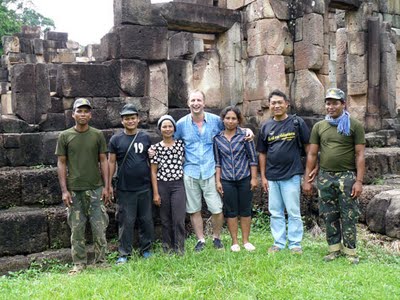 Off-duty Khmer and Thai troops, two local women and myself enjoy a moment of bonding at Prasat Ta Muen Thom
Off-duty Khmer and Thai troops, two local women and myself enjoy a moment of bonding at Prasat Ta Muen ThomLabels: Ta Muen Thom
It is 30 years since John Pilger revealed the existence of the Cambodian Killing Fields in the Daily Mirror. For Somaly Lun, the anniversary is bittersweet. Today, customers at the Oxfordshire supermarket checkout where she works have no idea of her extraordinary story. How she escaped US B-52 bombers as a child, a Khmer Rouge concentration camp as a teenager, and Vietnamese soldiers as a young woman. How she lost her father and six brothers to the Khmer Rouge. Somaly owes her life in the UK to Oxfam's Marcus Thompson, then a young humanitarian worker who had become friends with Somaly and her husband Borithy. "England gave me the first safe place I had ever lived," Somaly says.
By the time she was 10, her home town of Kratie was under attack, even though Cambodia was neutral. Kratie was close to the border with Vietnam which was at war with the States, and US President Richard Nixon ordered 100,000 tonnes of secret bombings. "The B-52s came every day," Somaly recalls. "Every day, shooting and bombing and running." One day a man grabbed her as an F-11 US fighter jet swept low and held her in front of him as a shield. "The plane was so low I could almost see the pilot's face," she says. It permanently damaged her hearing. Somaly's family fled to Phnom Penh, but by 1975 it had fallen to Pol Pot's Khmer Rouge. Backed by the US against the Vietnamese communists, the Khmer Rouge were determined to return Cambodia to Year Zero, to a time before industrialisation. "My father, a doctor, was in the middle of an operation the day the Khmer Rouge came," Somaly says. "He said, 'What about the patient?' They pointed a gun at him and asked, 'Do you want to die?'"
Somaly's family were herded out at gunpoint with two million other people. The family was taken to Pursat, a concentration camp in the remote countryside. Then the Khmer Rouge came for Somaly's father. "They said, 'We know you are a doctor'." The first time, they wanted him to treat one of the leaders. But the second time, "they took him away and he never came back". Somaly was forced to spend 20 hours a day as a slave doing hard labour in the rice fields despite starvation, exhaustion and malaria. Her older brother was caught saving his food rations for her. "They made him confess he was a US spy," she says. "They kept beating him until he died. Then my younger brother was taken. They put him in a prison with other children, and burned it to the ground. The screams have haunted me ever since. "One day, they came and took 2,000 people. One of the girls came back like a zombie with blood all over her. She said, 'They killed everyone'." Then, one day a pal whispered: "They are killing our parents and we have to escape now, tonight." Somaly says: "After dark we went to where people were gathered with three big boats." The Khmer Rouge chased them along the river, firing at the boats. She says: "We hid in the mangrove and caught fish and ate it raw as we didn't dare to make a fire. We drank muddy water. We all became sick - just skin and bones." Everyone on Somaly's boat was drifting in and out of consciousness. "But somehow it arrived by itself at Kampong Chhnang, where the Khmer Rouge was driven out," she says. "They gave us food, water, shelter."
New escapees from Pursat told Somaly that thousands had been taken to a cliff and forced off at gunpoint. Yet, somehow her mother, sister and brother had escaped. "The day I saw them again was the happiest day of my life," Somaly says. When they returned to Phnom Penh in 1979 they found a ghost city occupied by the Vietnamese liberators. Somaly took a job at the hotel Samaki - now Le Royale - as a receptionist, where she met Borithy, who was working for the Cambodian foreign office as a translator. She also met Marcus Thompson, a 34-year-old British aid worker sent by Oxfam to set up a humanitarian programme. "We became friends," he remembers. "We were all stuck together at the hotel." But Cambodia was still dangerous - and Borithy was warned to leave Phnom Penh. "He said he was in love with me and refused to leave without me," Somaly says. On March 16, 1980, the couple married in secret inside a destroyed pagoda. The next day, they escaped. Passing through fields of landmines, they made it through Vietnamese, then Khmer Rouge territory and even past the Thai border guards to Khao I Dang, a squalid refugee camp on the border. Somaly wrote to her family and to Marcus to tell them they were alive. "I needed to go to those camps as part of my work," Marcus says. Somaly says she will never forget seeing Marcus walking through the camp. "I cried out 'Marcus!' and just hung on to his neck," she says.Marcus was shocked by their plight. "They couldn't go back to Cambodia," he says. "The Thais wouldn't accept them. We had to do something." Back in England, Marcus and his Oxfam colleagues went through official channels to ask whether Britain would accept the family as refugees. "We had no expectation anything would happen," Marcus says. "But then we got a letter saying 'Yes'." Somaly, 22 and pregnant, arrived in the UK on May 12, 1981, with Borithy, Somaly's mother Moeun, brother Rithy and sister Virak - and settled close to Marcus and his family in Witney, Oxfordshire. "People at the Oxfam offices donated all kinds of furniture, saucepans, an old TV, carpets," Somaly remembers.
Today, the couple's daughters are success stories in their own right. The youngest, 23-year-old Bophanie, is a teacher in Brighton, while her sister, Mary Thida Lun, 27, is Assistant Private Secretary to the Minister of State for International Development, Gareth Thomas. At 64, Marcus still works as an adviser to Oxfam, and the charity remains working in Cambodia, still tackling the legacy of the dark days of the Khmer Rouge and facing new challenges from climate change, typhoons and flooding. Today, 30 years on, when she goes to and from work at the local supermarket, living her British life, Somaly sometimes remembers the words her father said to her before they took him away. "He said, 'You are going to survive. You are going to go places'." She shakes her head slowly. "I think that was what gave me the strength to survive."
Labels: Marcus Thompson, Somaly Lun
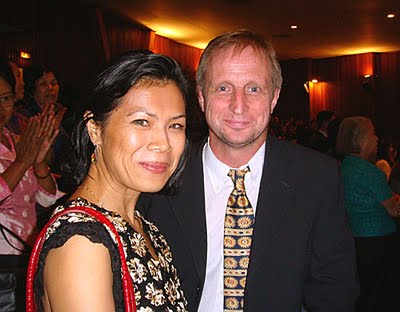 Yes that's me in a suit for the 1st time since I came to Cambodia, alongside my next seat neighbour, author and activist Theary Seng, who was great company
Yes that's me in a suit for the 1st time since I came to Cambodia, alongside my next seat neighbour, author and activist Theary Seng, who was great companyLabels: Sam Savin, Theary Seng, Ynav and Bosseba
Labels: Ynav and Bosseba
Thirty years ago, the Daily Mirror's John Pilger revealed to the world the horrors of Cambodia. Two million people had died in Pol Pot's killing fields and hundreds of thousands were starving. Pilger's award-winning reports warned there was just six months "to save three million people". Mirror readers raised enough money for a plane load of aid, and the reports kick-started a global humanitarian response. Here he recalls his horrifying trip into a country that had been closed to the outside world for four years.
The aircraft flew low, following the Mekong THE aircraft flew low, following the Mekong River west from Vietnam. Once over Cambodia, what we saw silenced all of us on board. There appeared to be nobody, no movement, not even an animal, as if the great population of Asia had stopped at the border. Whole villages were empty. Chairs and beds, pots and mats lay in the street, a car on its side, a bent bicycle. Behind fallen power lines lay or sat a single human shadow; it did not move. From the paddies, tall, wild grass followed straight lines. Fertilised by the remains of thousands upon thousands of men, women and children, these marked common graves in a nation where as many as two million people - or more than a quarter of the population - were "missing". At the liberation of the Nazi death camp in Belsen in 1945, The Times correspondent wrote: "It is my duty to describe something beyond the imagination of mankind." That was how I felt in 1979 when I entered Cambodia, a country sealed from the outside world for almost four years since "Year Zero".
Year Zero had begun shortly after sunrise on April 17, 1975, when Pol Pot's Khmer Rouge guerrillas entered the capital, Phnom Penh. They wore black and marched in single file along the wide boulevards. At 1pm, they ordered the city be abandoned. The sick and wounded were forced at gunpoint from their hospital beds; families were separated; the old and disabled fell beside the road. "Don't take anything with you," the men in black ordered. "You will be coming back tomorrow." Tomorrow never came. An age of owned cars and such "luxuries", anybody who lived in a city or town or had a modern skill, anybody who knew or worked with foreigners, was in grave danger; some were already under sentence of death. Of the Royal Cambodian Ballet company of 500 dancers, perhaps 30 survived. Doctors, nurses, engineers and teachers were starved, or worked to death, or murdered. For me, entering the silent, grey humidity of Phnom Penh was like walking into a city the size of Manchester in the wake of a nuclear cataclysm which had spared only the buildings. There was no power, no drinking water, no shops and no services. At the railway station trains stood empty. Personal belongings and pieces of clothing fluttered on the platforms, as they fluttered on the mass graves beyond.
I walked along Monivong Avenue to the National Library which had been converted to pigsty, as a symbol, all its books burned. It was dream-like. There was wasteland where the Gothic cathedral had stood - it had been dismantled stone by stone. When the afternoon monsoon rains broke, the deserted streets were suddenly awash with money. With every downpour a worthless fortune of new and unused banknotes sluiced out of the Bank of Cambodia, which the Khmer Rouge had blown up as they fled. Inside, a cheque book lay open on the counter. A pair of glasses rested on an open ledger. I slipped and I fell on a floor brittle with coins. For the first few hours I had no sense of even the remains of a population. The few human shapes I glimpsed seemed incoherent, and on catching sight of me, would flit into a doorway. In a crumbling Esso filling station an old woman and three emaciated infants squatted around a pot containing a mixture of roots and leaves, which bubbled over a fire fuelled with paper money. Such grotesque irony: people in need of everything had money to burn. At a primary school called Tuol Sleng, with that this I walked through what had become the "interrogation unit" and the "torture and massacre unit". Beneath iron beds I found blood and tufts of hair still on the floor. "Speaking is absolutely forbidden," said a sign.
Without milk and medicines, children were stricken with preventable disease like dysentery. It seemed that the very fabric of the society had begun to unravel. The first surveys revealed that many women had stopped menstruating. What compounded this was the isolation imposed on Cambodia by the West because its liberators, the Vietnamese, leaves over of paper had come from the wrong side of the Cold War, having driven America out of their country in 1975. Cambodia had been the West's dirty secret since President Richard Nixon and his national security adviser Henry Kissinger ordered a "secret bombing", extending the war in Vietnam into Cambodia in the early 70s, killing hundreds of thousands of peasants. "If this doesn't work, it'll be your ass, Henry," an aide heard Nixon say to Kissinger. It worked in handing Pol Pot his chance to seize power. When I arrived in the aftermath, no Western aid had reached Cambodia.
Only Oxfam defied the Foreign Office in London, which had lied that the Vietnamese were obstructing aid. In September 1979, a DC-8 jet took off from Luxembourg, filled with enough penicillin, vitamins and milk to restore some 70,000 children - all of it paid for by Daily Mirror readers who had responded to my reports and Eric Piper's pictures. On October 30, 1979, ITV broadcast Year Zero: The Silent Death Of Cambodia, the documentary I made with the late David Munro. Forty sacks of post arrived at the ATV studios in Birmingham, with £1million in the first few days. "This is for Cambodia," wrote an anonymous Bristol bus driver, enclosing his week's wage. A single parent sent her savings of £50.
People expressed that unremitting sense of decency and community which is at the core of British society. Unsolicited, they gave more than £20million. This helped rescue normal life in a faraway country. It restored a clean water supply in Phnom Penh, stocked hospitals and schools, supported orphanages and re-opened a desperately needed clothing factory. Such an extraordinary public outpouring broke the US and British governments' blockade of Cambodia. Incredibly, the Thatcher government had continued to support the defunct Pol Pot regime in the United Nations and even sent the SAS to train his exiled troops in camps in Thailand and Malaysia. Last March, the former SAS soldier Chris Ryan, now a best-selling author, lamented in a newspaper interview "when John Pilger, the foreign correspondent, discovered we were training the Khmer Rouge [we] were sent home and I had to return the £10,000 we'd been given for food and accommodation".
Today, Pol Pot is dead and several of his elderly henchmen are on trial in a UN/Cambodian court for crimes against humanity. Henry Kissinger, whose bombing opened the door to the nightmare of Year Zero, is still at large. Cambodians remain desperately poor, dependent on often-seedy tourism and sweated labour. For me, their resilience remains almost magical. In the years that followed their liberation, I never saw as many weddings or received as many wedding invitations. They became symbols of life and hope. And yet, only in Cambodia would a child ask an adult, as a 12-year-old asked me, with fear crossing his face: "Are you a friend? Please say."
Labels: John Pilger
Labels: Isaan, Ta Muen Thom
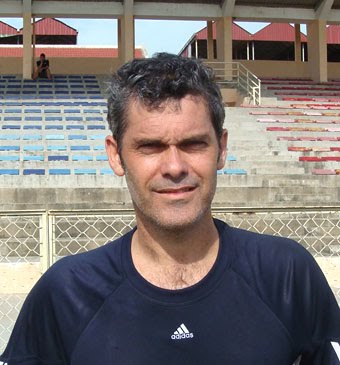 Cambodia's national team coach Scott O'Donell is currently putting his Under-23 squad through its paces in Saigon, Vietnam
Cambodia's national team coach Scott O'Donell is currently putting his Under-23 squad through its paces in Saigon, VietnamLabels: Cambodia U-23s, Scott O'Donell, SEA Games
Labels: Isaan, Phimai, Phnom Rung
Labels: Phnom Rung
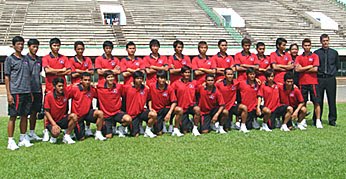
 Time for an update on the SEA Games that will take place in Laos from 9-18 December this year. It's the 25th SEA Games and there's been a building frenzy underway in Vientiane to accommodate all the sports that will be competed for by the 11 nations involved. Football is the main one as far as I'm concerned though Cambodia may have better chances to gain medals in such sports as petanque, where they won two gold medals in the last games in Khorat in 2007. The football competition will be competed for by the Under-23 teams from each country and Cambodia's U-23s have been busy preparing at their training camp in Saigon for the last few weeks. They return home to play in the 4-team BIDC Cup in Phnom Penh from 8-14 November when Laos U23 and two Vietnamese club sides, Hoang Anh Gia Lai (HAGL) and Vissai Ninh Binh will match up in a round-robin competition. The winners will receive $20,000 so its not to be sniffed at and the match practice will be just what the doctor ordered for Scott O'Donell's young team. As for the Laos U23 team, they've already won a 4-team pre-SEA Games tourney in Laos earlier this month, overcoming Thailand, Vietnam and Malaysia no less and will be itching to win again before hosting the SEA Games. Whilst the BIDC Cup is underway, Hanoi in Vietnam will host another 4-team U23 competition involving the hosts, Thailand, Singapore and China. It looks like everyone and their dog is getting games under their belt before the qualifying games start in earnest in Vientiane on 2nd December, a little earlier than the main competition dates. In the last SEA Games in Khorat in December 2007, the Cambodia U23s lost all three games, 3-1 to Indonesia, 8-0 to Thailand and 6-2 to Myanmar and that's where national coach Scott O'Donell is looking to improve. To qualify would be a major achievement for the Cambodian team though an improvement on their last showing is their immediate aim. The qualifying round draw has yet to take place. Thailand have won the football competition for 8 consecutive SEA Games, beating Myanmar in the 2007 final, 2-0.
Time for an update on the SEA Games that will take place in Laos from 9-18 December this year. It's the 25th SEA Games and there's been a building frenzy underway in Vientiane to accommodate all the sports that will be competed for by the 11 nations involved. Football is the main one as far as I'm concerned though Cambodia may have better chances to gain medals in such sports as petanque, where they won two gold medals in the last games in Khorat in 2007. The football competition will be competed for by the Under-23 teams from each country and Cambodia's U-23s have been busy preparing at their training camp in Saigon for the last few weeks. They return home to play in the 4-team BIDC Cup in Phnom Penh from 8-14 November when Laos U23 and two Vietnamese club sides, Hoang Anh Gia Lai (HAGL) and Vissai Ninh Binh will match up in a round-robin competition. The winners will receive $20,000 so its not to be sniffed at and the match practice will be just what the doctor ordered for Scott O'Donell's young team. As for the Laos U23 team, they've already won a 4-team pre-SEA Games tourney in Laos earlier this month, overcoming Thailand, Vietnam and Malaysia no less and will be itching to win again before hosting the SEA Games. Whilst the BIDC Cup is underway, Hanoi in Vietnam will host another 4-team U23 competition involving the hosts, Thailand, Singapore and China. It looks like everyone and their dog is getting games under their belt before the qualifying games start in earnest in Vientiane on 2nd December, a little earlier than the main competition dates. In the last SEA Games in Khorat in December 2007, the Cambodia U23s lost all three games, 3-1 to Indonesia, 8-0 to Thailand and 6-2 to Myanmar and that's where national coach Scott O'Donell is looking to improve. To qualify would be a major achievement for the Cambodian team though an improvement on their last showing is their immediate aim. The qualifying round draw has yet to take place. Thailand have won the football competition for 8 consecutive SEA Games, beating Myanmar in the 2007 final, 2-0.Labels: Cambodia U-23s, SEA Games
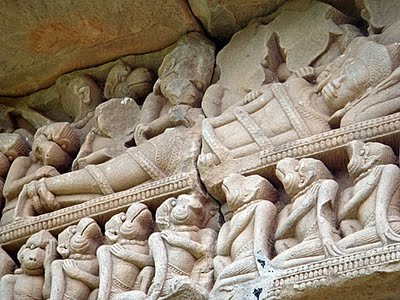 A part of the lintel on the west of the mandapa at Phimai showing Rama trapped by the coils of a naga with monkey troops in attendance
A part of the lintel on the west of the mandapa at Phimai showing Rama trapped by the coils of a naga with monkey troops in attendance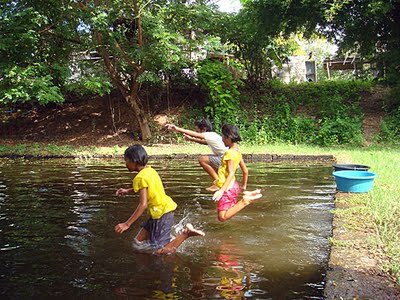 Three more young girls, this time taking turns to launch themselves into the pool at Kuti Rishi Ban Khok Mueang
Three more young girls, this time taking turns to launch themselves into the pool at Kuti Rishi Ban Khok Mueang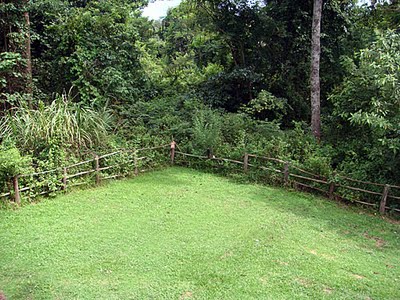 This doesn't look like a conflict zone does it, but its the fence that separates the Thai and Cambodian troops at Prasat Ta Muen Thom on the disputed borderline
This doesn't look like a conflict zone does it, but its the fence that separates the Thai and Cambodian troops at Prasat Ta Muen Thom on the disputed borderlineLabels: Isaan
Labels: Phnom Penh
Labels: Phimai
Labels: Bangkok
Labels: Bangkok
Labels: Isaan
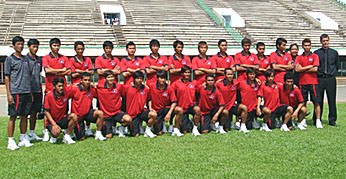 Yes I know I'm late with the football news, but I have an excuse...I'm in northeast Thailand.
Yes I know I'm late with the football news, but I have an excuse...I'm in northeast Thailand.Labels: Cambodia U-23s, Scott O'Donell
Labels: Isaan, Phanom Rung, Ta Mueang Tam, Ta Muen Thom
Labels: Isaan, Khorat, Phanom Wan, Phimai
Labels: Isaan
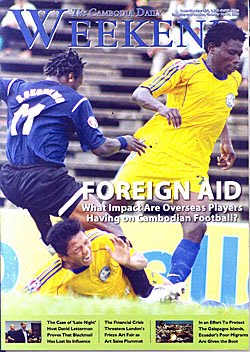 Kudos to Monument Books who were able to supply me with a copy of last week's Weekend edition of the Cambodia Daily. As I was away I missed the article that dominated the edition's front cover: Foreign Aid - what impact are overseas players having on Cambodian football? by reporter Eoin Redahan. I don't know the author of the article, even though I attend all of the CPL games, give or take one or two midweek games, and the Cambodia Daily's usual coverage of Cambodian football is virtually non-existent. So it was good to see they've at last got their finger out of their arse to put this story into print last week. The focus of the story is the question - is their [foreign footballers] presence constructive or destructive? - and comments from the country's national football coach Scott O'Donell were included, alongwith statements from Ken Gadaffi, president of the Nigerian Community Association. Ken reports on local sport for the Phnom Penh Post and as the majority of the 37 foreigners playing football in Cambodia are Nigerian, the author sought out his opinion. As you might expect, Ken views the foreign contribution, the majority of whom are African, as positive (he wants to raise the limit of foreign players at each club), whilst O'Donell's take is slightly different, bemoaning the lack of real quality professionals amongst the imports that can contribute to improving the standard of the local players. It's a viewpoint I agree with. Cambodian football is in a state of flux, the professionalism of the club sides is improving, but there is so much more to be done. Money is a big factor, as the wages currently paid here, will not attract the better standard of pro's that seek their fame and fortune in neighbouring leagues, such as Thailand, Vietnam and Singapore. The most important factor is the development of the local Cambodian players and this will be greatly influenced if more qualified coaches come to ply their trade here and raise the bar in terms of fitness and technique, alongside the recruitment of better quality foreign players - all pretty obvious but it ain't gonna happen overnight. Progress has been made but we're still on the starting blocks as far as Cambodia competing domestically and internationally with their Asian neighbours, let alone further afield.
Kudos to Monument Books who were able to supply me with a copy of last week's Weekend edition of the Cambodia Daily. As I was away I missed the article that dominated the edition's front cover: Foreign Aid - what impact are overseas players having on Cambodian football? by reporter Eoin Redahan. I don't know the author of the article, even though I attend all of the CPL games, give or take one or two midweek games, and the Cambodia Daily's usual coverage of Cambodian football is virtually non-existent. So it was good to see they've at last got their finger out of their arse to put this story into print last week. The focus of the story is the question - is their [foreign footballers] presence constructive or destructive? - and comments from the country's national football coach Scott O'Donell were included, alongwith statements from Ken Gadaffi, president of the Nigerian Community Association. Ken reports on local sport for the Phnom Penh Post and as the majority of the 37 foreigners playing football in Cambodia are Nigerian, the author sought out his opinion. As you might expect, Ken views the foreign contribution, the majority of whom are African, as positive (he wants to raise the limit of foreign players at each club), whilst O'Donell's take is slightly different, bemoaning the lack of real quality professionals amongst the imports that can contribute to improving the standard of the local players. It's a viewpoint I agree with. Cambodian football is in a state of flux, the professionalism of the club sides is improving, but there is so much more to be done. Money is a big factor, as the wages currently paid here, will not attract the better standard of pro's that seek their fame and fortune in neighbouring leagues, such as Thailand, Vietnam and Singapore. The most important factor is the development of the local Cambodian players and this will be greatly influenced if more qualified coaches come to ply their trade here and raise the bar in terms of fitness and technique, alongside the recruitment of better quality foreign players - all pretty obvious but it ain't gonna happen overnight. Progress has been made but we're still on the starting blocks as far as Cambodia competing domestically and internationally with their Asian neighbours, let alone further afield.Labels: Cambodian Premier League, Scott O'Donell
Labels: Isaan
Labels: Hanuman
Labels: Isaan
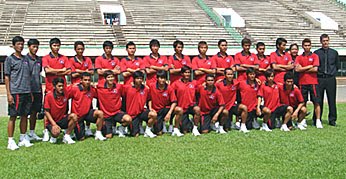 The Cambodian Under-23s are now well into their training camp in Saigon, across the border in Vietnam, and played a practice match against Thu Duc Central Sports University yesterday, losing 1-nil. The players who weren't involved in the previous friendly against Ho Chi Minh City were given a run out, though the less said about the game the better. Their next match against a V-League club side will be on Sunday 18th against Dong Hai Bien Hoa. The U23s will return home in time for the 4-team BIDC Cup which will be played in Phnom Penh in early November though their real aim is to gain medals at the SEA Games football championships in Laos at the beginning of December. A tall order but that's the target.
The Cambodian Under-23s are now well into their training camp in Saigon, across the border in Vietnam, and played a practice match against Thu Duc Central Sports University yesterday, losing 1-nil. The players who weren't involved in the previous friendly against Ho Chi Minh City were given a run out, though the less said about the game the better. Their next match against a V-League club side will be on Sunday 18th against Dong Hai Bien Hoa. The U23s will return home in time for the 4-team BIDC Cup which will be played in Phnom Penh in early November though their real aim is to gain medals at the SEA Games football championships in Laos at the beginning of December. A tall order but that's the target.Labels: Cambodia U-23s
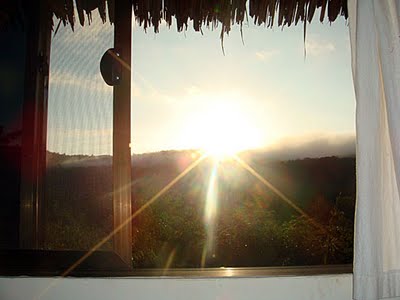 The view through my window at Rainbow Lodge at 6am this morning as the sun peered over the hills and across the river
The view through my window at Rainbow Lodge at 6am this morning as the sun peered over the hills and across the river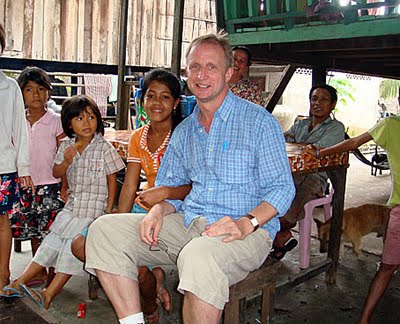 The adorable Srey Roath and me at the fishing village of Koh Kapik. We were walking through the village, she grabbed my hand and next minute, we were eating food at her mother's stall.
The adorable Srey Roath and me at the fishing village of Koh Kapik. We were walking through the village, she grabbed my hand and next minute, we were eating food at her mother's stall.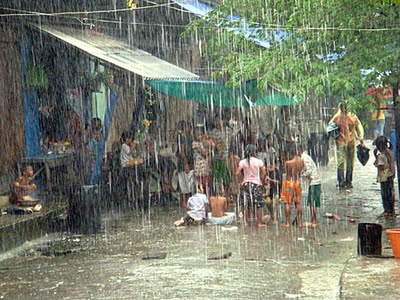 The children at Koh Kapik were great fun and this game of It's A Knockout in the pouring rain was a real joy
The children at Koh Kapik were great fun and this game of It's A Knockout in the pouring rain was a real joy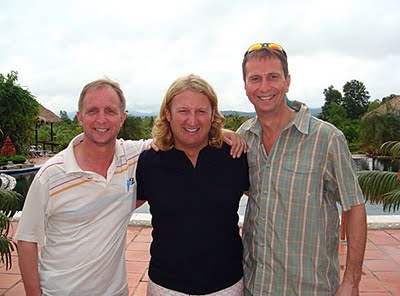 The rain stopped for a minute allowing this photo at the Oasis Resort in Koh Kong. LtoR: me, Jason (proprietor of Oasis and all-round nice-guy) and Tim.
The rain stopped for a minute allowing this photo at the Oasis Resort in Koh Kong. LtoR: me, Jason (proprietor of Oasis and all-round nice-guy) and Tim.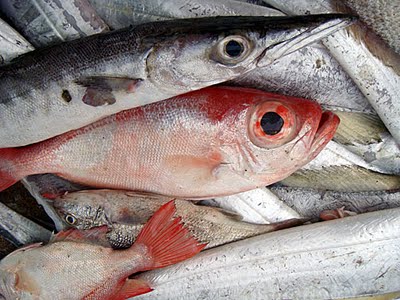 Catch of the day at the Muslim fishing village a couple of kilometres from Koh Kong town
Catch of the day at the Muslim fishing village a couple of kilometres from Koh Kong townLabels: 4Rivers Tatai, Koh Kong, Rainbow Lodge
Labels: Koh Kong, Peam Krasaop
Labels: Cambodia U-23s, Scott O'Donell
Labels: Koh Kong
Labels: Eric de Vries, Now
Labels: BIDC Cup, Cambodia U-23s
Labels: Belle, Mekong Orchards
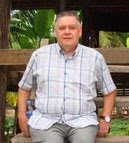 Today began with a conversation with one of the most interesting people you are likely to meet in Cambodia. Darryl Collins (right) is a mine of information. Our conversation centered mainly on the National Museum, here in Phnom Penh and the work going on behind the scenes to document the museum's amazing collection of artifacts, which number upwards of 19,000, though only 2,000 are on show at any one time. He was full of praise for the professional way that the director Hab Touch has brought the museum up by the scruff of its neck, though it remains reliant on grants and individual contributions to maintain itself. The Collection Inventory Project is a labour of love that has been on-going now for a couple of years and which Darryl has been instrumental in training the project team of nine people. It is the first real attempt to catalogue, photograph and stock-take the museum's collection and an absolutely vital task to ensure the provenance of the collection as well as a window on the artifacts that have disappeared over the years. You can read more about the CIP on the museum's excellent website. Darryl now resides in Siem Reap and was joint author with Helen Grant Ross of the book, Building Cambodia: New Khmer Architecture 1953-1970. He began work on the CIP in 2004 after completing five years as a lecturer at the Royal University of Fine Arts. He's also known for relocating a 100 year old historic Chinese-Khmer wooden house, piece by piece, from an island in Kompong Cham to its new home in Siem Reap.
Today began with a conversation with one of the most interesting people you are likely to meet in Cambodia. Darryl Collins (right) is a mine of information. Our conversation centered mainly on the National Museum, here in Phnom Penh and the work going on behind the scenes to document the museum's amazing collection of artifacts, which number upwards of 19,000, though only 2,000 are on show at any one time. He was full of praise for the professional way that the director Hab Touch has brought the museum up by the scruff of its neck, though it remains reliant on grants and individual contributions to maintain itself. The Collection Inventory Project is a labour of love that has been on-going now for a couple of years and which Darryl has been instrumental in training the project team of nine people. It is the first real attempt to catalogue, photograph and stock-take the museum's collection and an absolutely vital task to ensure the provenance of the collection as well as a window on the artifacts that have disappeared over the years. You can read more about the CIP on the museum's excellent website. Darryl now resides in Siem Reap and was joint author with Helen Grant Ross of the book, Building Cambodia: New Khmer Architecture 1953-1970. He began work on the CIP in 2004 after completing five years as a lecturer at the Royal University of Fine Arts. He's also known for relocating a 100 year old historic Chinese-Khmer wooden house, piece by piece, from an island in Kompong Cham to its new home in Siem Reap.Labels: Darryl Collins, National Museum
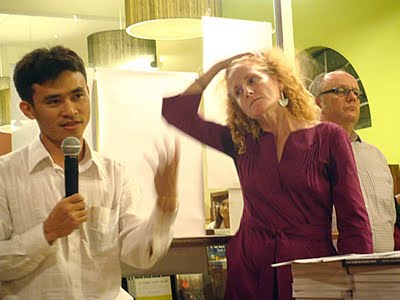 Anne Heindel having a hair moment whilst book contributor Terith Chy has the microphone. William Bagley is behind Anne.
Anne Heindel having a hair moment whilst book contributor Terith Chy has the microphone. William Bagley is behind Anne.Labels: On Trial, The Disappeared
Labels: Cambodian Premier League, Phnom Penh Post